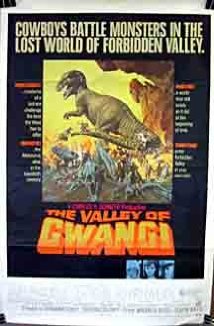The Valley of Gwangi is a film that, through cult enjoyment of its quality, has managed to overcome the problems that made it “forgotten” in motion pictures to enjoy its present status as a fantasy classic.
Originally written by King Kong’s Willis O’Brien, Gwangi’s script was never filmed, but a copy owned by Ray Harryhausen stored in his garage was resurrected in 1966. With additional work by writer William Bast, The Valley Of Gwangi was approved by Kenneth Hyman of Seven Arts Inc, which had financed Harryhausen’s film with Raquel Welsh, One Million Years B.C. and who had purchased into the Warner Brothers studio.
Filming took place in Spain and lasted two years, mostly due to the time needed by Harryhausen to animate the dinosaurs. Given that the film employed over 300 animation shots (the most of any Harryhausen film), it was expected that release would not come until two years after principal photography had been completed.
The extra time paid off in Harryhausen’s best animation. Adding enormously were the superior sound FX employed by Warner Brothers, giving dinosaur voices far more menacing and believeable than those used by Columbia or Hammer; attention to peripheral sound FX is also striking, notably in the finale within the enormous cathedral, where the echo of Gwangi’s breathing and footsteps adds greatly to the drama.
The human cast also works well, notably star James Franciscus. The story involves the efforts of a struggling wild west show in circa-1900 Mexico. To boost attendance, owner T.J. Breckenridge (Gila Golan, cast in the film as a favor to Ken Hyman) has found a tiny horse – which turns out to be a prehistoric Eohippus, and which comes from a Forbidden Valley filled with dinosaurs. One is known as Gwangi, a belligerent allosaur that, after an extremely long chase that sidetracks to a bloody battle with a styracosaur, is captured and put on display in T.J.’s show, only to be set free and rampage through the nearby town.
Harryhausen’s animation is the film’s highlight, but the performances, Erwin Hillier’s cinematography, and Jerome Moross’ superb score all add up to an immensely enjoyable film. It suffered, though, as Kenneth Hyman was let go during filming and new Warners management released the film without publicity and as part of a double-bill with a biker film, thus missing the youthful audience that was the film’s target. The film was largely forgotten until cult attention in the 1980s and ’90s elevated general interest and has made it a favorite of fantasy film buffs.

